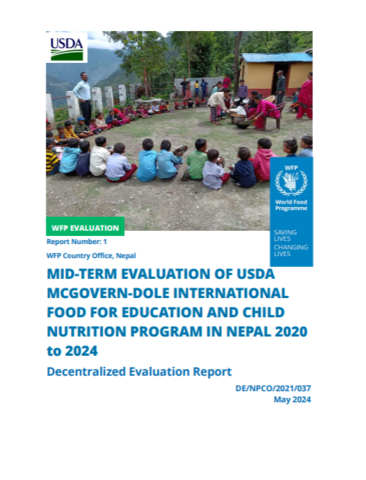
This decentralized evaluation is the Mid-Term evaluation (MTE) of the Fiscal Year 20 (FY20) of the United States Department of Agriculture (USDA) McGovern-Dole International Food for Education and Child Nutrition Program 2020-2024. It was carried out in 2023. The project area lies in Jajarkot of Karnali Province and Doti, Achham, Bajhang, Darchula, and Bajura of Sudurpaschim province of Nepal.
The evaluation was commissioned by WFP Nepal Country Office to objectively review the progress of implementation to generate recommendations to strengthen project implementation, with two mutually reinforcing objectives- accountability and learning. It focused on assessing the coherence, relevance, effectiveness, efficiency, impact and sustainability as well as lessons learnt.
Overarching evaluation questions include the assessments of the project alignment to the needs of beneficiaries and national policies, achievement of results so far, efficiency of systems, analysis, and tools that have been put in place to support the project, intermediate effects of the project among direct beneficiaries and results of WFP’s capacity strengthening work in a sustainable program.
Key evaluation findings included:
- The WFP's school feeding model has been highly flexible, supportive of, and aligned with the NSMP in preparation for handover. The WFP's flexibility to go with the government's universal targeting approach is timely and contributed to institutionalising and scaling out NSMP across the country.
- By targeting the country's remote, food-insecure mountainous and hill districts, the project complemented the country's food security objectives and strategies and reducing multidimensional poverty.
- Out of 29 outcome targets, the mid-term values of 25 targets (86%) were improved compared with the baseline. The evaluation found eight targets (27.6%) already achieved, 19 (65.6%) on track likely to be achieved ceteris paribus, and two unlikely to be achieved given the high and ambitious standards set by the baseline survey. Project activities such as working with and through local governments, local governments (LGs), capacity strengthening related activities, establishing business linkages with the cooperative/farmer groups and schools, and technical training for farmers contributed towards the achievement of the project results.
- The project successfully provided equal opportunity for students from different castes, especially in food distribution and improved the enrollment of girl children by sensitizing parents and serving meals at school. The situation for both boys and girls improved after baseline with a marginal difference between boys and girls. However, the evaluation found that more girls than boys benefitted because of the tendency of people in rural areas to send girls to community schools and boys to institutional/private schools.
- The project is efficient, considering that with 75% of the time elapsed, the financial delivery is 71.7%. All key stakeholders acknowledged the WFP's approach, especially supporting a transition to the national school feeding program and enhancing LGs' capacity.
- While the Ministry of Education, Science and Technology (MoEST) is convinced that the effectiveness of the mid-day meal will be increased when it is integrated with School Health and Nutrition and support to smallholder farmers, sectoral responsibilities distributed among different ministries make it difficult to take a leading and coordinating role.
- Several unintended positive outcomes included a contribution to the annual household (HH) income (US$ 20.0 per HH per year) by providing mid-day-meal to students; creating opportunities for women to sell surplus agricultural products to the neighboring schools; changing gender roles by increased participation of men in kitchens at homes and reduction in caste-based discriminations (e.g., using any persons from any castes/ethnicities to cook meals).
Key recommendations from the evaluation included :
- Review and prioritize project activities to achieve and sustain project results;
- Encourage linkages between Local Governments (LGs), Schools and Farmers Organizations for effective implementation of the Home Grown School Feeding (HGSF) approach;
- Further, strengthen the capacity of LGs and other key stakeholders, especially, MoEST, the Ministry of Health and Population, provincial governments and the Ministry of Agriculture and Livestock Development towards the sustainable transition to the National School Feeding Program along the HGSF approach;
- Support affirmative action to improve literacy outcomes prioritizing girls.



